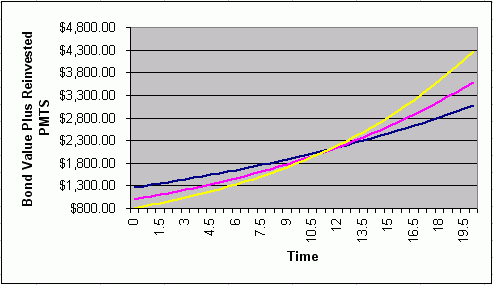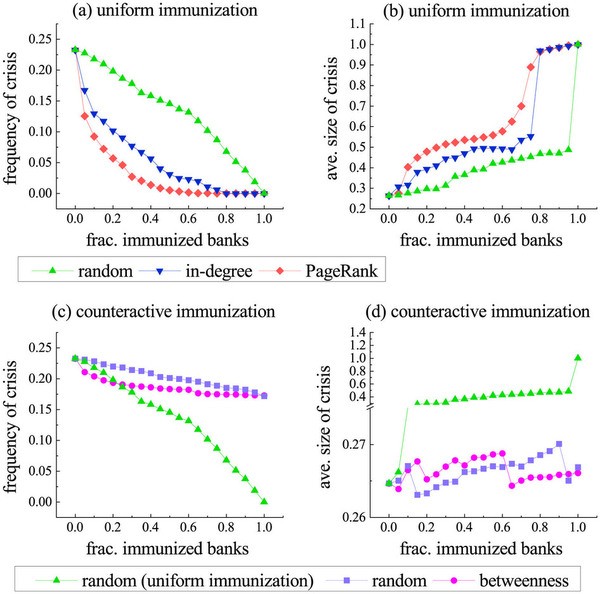WWWFinance Bond Immunization
Post on: 17 Апрель, 2015 No Comment

Bond Immunization
When investors talk about the interest rate risk of bonds, they usually mean the risk to their capital investment. Duration is used to measure risk, by letting them know how much a bond’s price should change for a small change in interest rates.
Suppose that an investor must make a $1,000,000 payment in five years. To simplify the problem, suppose that he has three investment opportunities. He can buy four year zero coupon bonds, five year zero coupon bonds, or six year zero coupon bonds.
If the investor buys the six year zero coupon bond, he will have to sell it in five years to make his payment. If rates are where he expects them to be, he should be able to make that payment. If rates are lower, then the bond will be worth more than he expected, and he will have a surplus of cash after paying the liability. But if rates are higher than he expected, then the price of the bond will be lower than he thought, and he might not be able to make the $1,000,000 payment. The Macaulay duration of the bond is 6 years. We can also calculate the duration of the liability payment. Since it is a single flow due in five years, its duration is 5 years. Because the duration of the bond is longer than the duration of the liability, its value will be more sensitive to changes in yield.
If he buys the four year zero, instead, then he can hold on to it until it matures. At that point, he can reinvest it for a period of one year. If rates are high when the bond matures, he should be able to make the liability payment. He will probably even have a surplus. If rates drop, though, he might not have enough money to make the payment. The investor has left himself open to interest rate risk, but in this case it is not the price risk that we saw earlier. Reinvestment risk is another form of interest rate risk. Duration can still be used to measure this risk, as long as there is either an investment horizon or a stream of liabilities involved. In this case, we can look at the duration of the asset (4 years) and the duration of the liability (5 years). Since the asset’s duration is shorter than that of the liability, we can infer that there is reinvestment risk rather than price risk.
If the investor bought a five year zero that paid $1,000,000, then he will be able to pay off his liabilities no matter what happens to interest rates. If rates go up during that period, the price of the bond will fall. But the investor is insensitive to this, because the present value of the liability also falls by an equal amount. Similarly, if rates go down then he is insensitive to the reinvestment rate, because he will not be reinvesting any cash flows during that period.
The above example is a simple one, but can be generalized. Bond portfolios are often set up to provide the funds needed to pay off a stream of liabilities. The above analysis might lead us to believe that zero coupon bonds should be bought to pay each of the liabilities. If the schedule of payments goes for several years, and several payments must be made each year, it might actually be cheaper to buy some coupon bearing bonds. The final payment of a bond could be used to pay off most of one liability payment, while its coupons pay off a smaller portion of earlier liability payments. This type of problem lends itself to linear programming techniques. A model can be set up which picks the cheapest portfolio of bonds that provides funds for the liability schedule. Such a portfolio is often called a cash matched portfolio, or a dedicated portfolio.
Matching the cash flows of assets and liabilities is not the only way to avoid interest rate risk. Suppose that we get rid of the simplifying assumption used above to fund the $1,000,000 payment in five years. Suppose that the portfolio manager is still restricted to investing in those three zero coupon bonds, but he is now allowed to invest in a mix of the four year zero and the six year zero. We saw that when rates went up, that was good for reinvesting the four year zero, but bad for the price of the six year. On the other hand, when rates went down, it was bad for reinvesting the four year but good for the price of the six year. If the portfolio manager could figure out some way to set up his portfolio so that the reinvestment risk associated with the four year bond exactly canceled out the price risk of the six year bond, then it would be immune to interest rate shifts. He might be interested in doing this if it is a cheaper way to fund the liability payment.
In a world where short and long term interest rates shift in parallel, he could do this by matching the duration of his assets with the duration of his liabilities. If he bought equal present values of the four and six year zeros, then the Macaulay duration of his portfolio would be five years. If interest rates shifted, the present value of liability would shift by the same amount as the value of the portfolio. But the world of interest rates is not ideal. If short term interest rates drop, but longer interest rates rise, we would have the worst of all possible situations. He would not get the reinvestment that he needs from the four year, and would get less than he expects from the price change on the six year.
To get around this problem, we might also try matching up the convexity of the assets with the convexity of the liabilities. This is difficult to do with a one payment liability, unless it is funded with a zero coupon bond. But if there are multiple liability payments, then it is possible to match the duration and convexity of the assets with the liability schedule. As with the dedicated portfolio, this can be done easily with a linear programming model. A portfolio with these properties is called an immunized portfolio. It is also sometimes referred to as a duration-matched portfolio.

Dedicating or immunizing portfolios are considered passive strategies. The portfolio manager who dedicates a portfolio can almost forget about managing it. Cash will always be there when he needs it. It is a good idea to rebalance the portfolio occasionally. Sometimes new bonds that are cheaper or a better fit will become available. When this happens, cash can be taken out of the portfolio.
Immunized portfolios need more nurturing. As time passes, the duration and convexity of the portfolio and the liabilities will shift. They must be checked periodically to make sure that they are still matched. The immunization process also relies on the fact that bonds will have to be sold occasionally in order to make payments. Because of this feature, another constraint is often added when creating an immunized portfolio to make sure that the first several liability payments can be made without selling securities.
For more information, see the chapters on Bond Immunization and Dedicated Portfolios in The Handbook of Fixed Income Securities. edited by Fabozzi and Pollack. The second year course Money and Capital Markets deals with these concepts in much more detail.
Acknowledgement
This note was written by Mark Taranto, October 1995.














